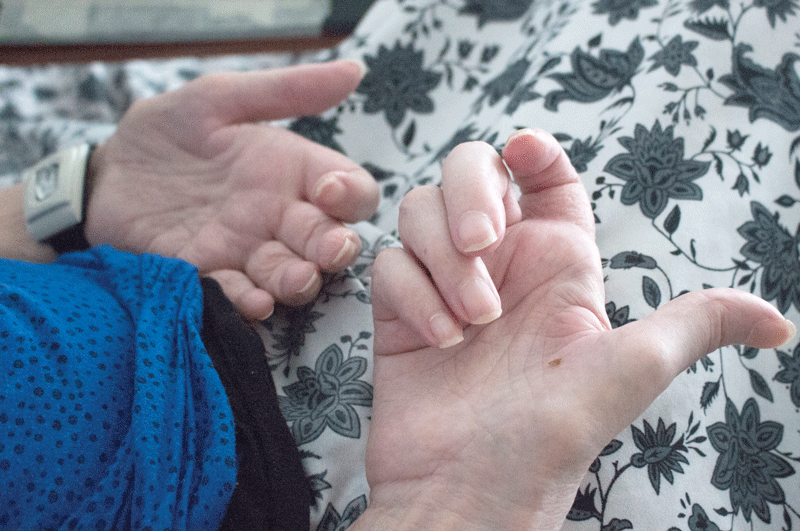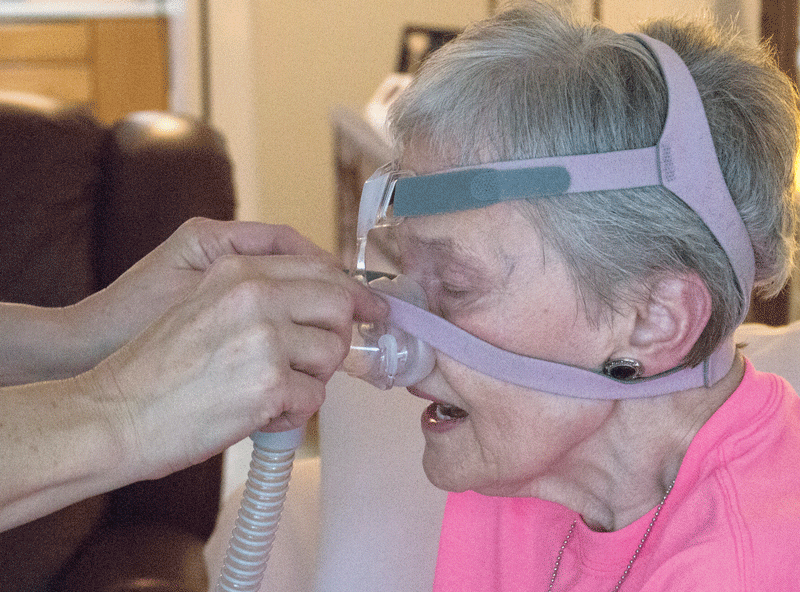Beyond the Ice Bucket
Living with ALS
STORY BY STEFANIE DONAHUE
photos by Rachel Brown
Propped above Nelda Lautenbach’s twin-sized bed sits a carefully arranged portable desktop. A mobile tablet is positioned in place next to a phone equipped with felt pads to make dialing easier. An arms-length away rests a plastic water bottle with a pill to its side.
For Lautenbach, a resident of Lynden, movement is not always an easy feat. Diagnosed with Amyotrophic Lateral Sclerosis (ALS) in 2011, she has delicately arranged her home to make basic necessities accessible and user-friendly.
It may seem easy — a quick handshake, a single step. But what feels effortless to many is not as easy for those across the globe with ALS, also referred to as Lou Gehrig’s Disease. The disease caught the attention of many in summer of 2014 following the viral success of the ALS Ice Bucket Challenge, which prompted thousands to spread awareness and raise funds for the cause. As a result, the ALS Association raised people’s eyes and ears,” says Rick Meek, chief development officer for the association’s Evergreen Chapter, which spans to Washington, Idaho, Montana and Alaska.
The widely-acclaimed social media phenomenon required an individual to poor a bucket of iced water on themselves following a nomination. Videos were typically posted to Facebook or Twitter, and nominees were encouraged to donate to the cause.
As a result, the ALS Association generated $113 million from July 29 to Aug. 28, Meek says. Regionally, the Evergreen Chapter brought in about $100,000 in that same time period — “And the number is still growing,” he says.

The ALS Association estimates that up to 30,000 people in the United States have ALS at any given time. The disease progressively degenerates nerve cells and motor neurons located in the brain and spinal cord. Over time, ALS patients lose the ability to control muscle movement, which may lead to complete paralysis and eventually death.
The disease is not contagious and can strike anyone, according to the ALS Association. While there is medication on the market intended to prolong life, there is currently no cure or treatment that stops or reverses symptoms.
LOOKING IN
When 68-year-old Lautenbach stopped feeling like herself about four years ago, she knew something was wrong.
“I always had a little twitch in my stomach,” she says.
“What’s wrong with me?” she wondered.
After spending time online researching her symptoms she started to realize that she could have ALS. She later received confirmation from a neurologist.
“I went, oh no. Oh no. Oh no,” she says. Lautenbach admits she completely fell apart.
Now, Lautenbach spends most of her time at home in Lynden. She requires daily care to help her eat, shower and go to the restroom.
“Why this happens? I don’t know,” says her niece and caregiver Kelli Tuttle. “There is no rhyme or reason.”
Tuttle calls herself “the manager” and is at Lautenbach’s home four days a week, helping manage her day-to-day care, she says.
As late as 8 p.m., one of Lautenbach’s caregivers comes to her home to stay the night and prepare her for bed. By 7:30 a.m. the caregiver is out the door. At noon, her sister-in-law stops by to help her eat, and by 4 p.m. someone comes in to help her go to the bathroom and eat. The routine begins again the next morning.
“[If you] sit here all by yourself all day, it is pretty boring,” she says. “I never thought I’d be laying here not being able to drive my car.”
But despite the challenges Lautenbach encounters each day, Tuttle says she has a remarkable ability to remain positive.
“Nelda has had the best attitude that I’ve ever seen,” Tuttle says. “It is very rare that I see her in a down mood.”
While Lautenbach admits that life with such a physically debilitating disease is not easy, she takes it one day at a time. She says one of her biggest pains is having to trade in a seat at her grandson’s football game for a radio broadcast from home. But at any chance she gets, she praises her grandchildren’s accomplishments.
It’s kind of a mantra that I promote with people. About living with ALS, not dying with ALS.
Although Lautenbach typically remains at home, she is quite often accompanied by friends and family. In fact, being alone seems to be a rare occurrence for Lautenbach, who was raised in the area. The support she has received since receiving her diagnosis has been overwhelmingly positive, she says.
Lautenbach is still in touch with friends from high school, she says. Some of whom she had not seen in 50 years visited her home to help build a ramp leading to her door.
“It’s unbelievable,” Lautenbach says. “One car after the other comes to visit.”
Support is extremely important for those with ALS, says Oliver Ross, full-time North Sound Care Coordinator for the ALS Association’s Evergreen Chapter.
Ross has worked with the ALS Association for about a year and a half and facilitates an ALS support group once a month at St. Luke’s Community Health Education Center in Bellingham.
“[It is] harder when you are in the community, to not be viewed as just the disease,” he says. “There is an alienation that I feel is just inherent with the disease.”
Ross is a professionally trained nurse and lived in Bellingham for several years. Now, he lives in Everett.
He says the best part of the job is encountering people who are living intentionally.
“It’s kind of the mantra that I promote with people,” he says. “About living with ALS, not dying with ALS.
Ross got involved with the ALS Association after growing close with someone who had the disease at the iDiOM Theater in Bellingham. After his friend was diagnosed, Ross and two others became his caretakers.
Following the death of his friend in 2009, Ross decided to get involved and has dedicated his time to working with the ALS Association. Now, his full-time job allows him to serve locations north of Snohomish County up to Alaska.
LOCAL SUPPORT
On top of donations flooding in from the summer of 2014’s Ice Bucket Challenge, volunteers from across the country have participated in fundraising events to support the ALS Community. The challenge attached a face to the disease and prompted the public to research and educate themselves on the disease, which impacts thousands each year, Meek says.
“Now we can have a conversation,” he says.
In Bellingham, the Evergreen Chapter, one of 38 Association chapters, hosted its annual Walk to Defeat ALS in September and saw a record number of participants. The local chapter brought in $76,917 in the walk, compared to $47,200 — the estimated goal the chapter had originally aimed to hit this year, Meek says.
“That’s huge,” Meek says. “Walks in the past never doubled.”
In the past year, the ALS Association allocated 32 percent of their funding to public and professional education, and the remaining money went to research, patient and community services, fundraising and administration, according to the ALS Association.
Public education tops the list because it’s important, since those with the diagnosis are cared for by loved ones instead of medical professionals. Typically, Meek says, there is no therapy or clinical care and about 90 percent of patients with ALS experience the journey at home.
“It effects a village,” he says. “With any disease, it affects more than just the patient.”

The ALS Association could not survive without its base of volunteers, Meek says. Volunteers not only plan community events and fundraisers, but also support families directly, he says.
Some of the most motivated and committed volunteers have the disease, he says.
“They come to grips to the fact that [ALS] is irreversible,” he says. “Most of them try to build a life around their limitations.”
For Lautenbach, it is important to take in each day at a time. She says she is happy each morning, opens her eyes to a new day, and offers a few words of advice —
“Enjoy your lives and don’t complain,” she says. “Life can just change overnight.”